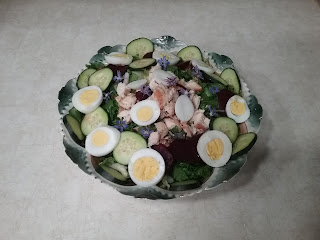The Challenge: Summer Sun. Try a food suitable for summer, or involving the sun.
The Recipe: Summer Salad (#1754) from Warne's Model Cookery and House-Keeping Book
The Date/Year and Region: 1879, London
How Did You Make It: I started by making some terragon vinegar (small hand full of fresh terragon in ~2 Tbsp of white wine vinegar, left overnight to steep).
Next, I boiled two small beets and three eggs. While those cooked, I started on the salad "mixture"/dressing. Since the receipt gave a choice of salad mixture/dressing, I opted for #1745, which is an oil and vinegar combination. [#1747 is nigh identical to the one from Beeton's chicken salad, so I'm sure it would be lovely here as well.] I combined 3 Tbsp of olive oil ("salad oil") with 1/2 Tbsp each of the terragon vinegar and plain white wine vinegar, then added 1 tsp of salt and a pinch of ground black pepper. I poured this into the bottom of the salad bowl.
I then washed and chopped half of a head of green lettuce, 1 bunch of mustard greens, and a generous handful of watercress. I also sliced two small radishes and mixed them with the greens, and placed them all in the bowl, mixed together.
*Since it didn't specify radish greens, I thought I'd finally found a 19th century recipe that uses the root rather than the pods or greens. Having made this, I think the greens were actually meant.
I cut up some leftover chicken breast and piled it in the center of the greens.I then sliced half of a cucumber, as well as the boiled eggs and beets, and arranged them around the top. I finished by garnishing with borage flowers.
Time to Complete: Excluding the vinegar steeping, about 30 minutes, including boiling the eggs and beets.
Total Cost: Don't want to think about it. I bought greens (since I wasn't making this as a demo in the middle of a historic kitchen garden), and it was pricey.
How Successful Was It?: Perfectly adequate salad. It reminds me a lot of the salad I usually make from Beeton's, so I found it interesting to try a slightly different take on it. In a way, I think it's helping me to understand how a period chicken salad works and what components are considered to go well together. Here, instead of endive or nasturtiums, the cress and mustard are taking the 'spicy kick' role, while the lettuce/chicken/egg/cucumber/boiled beet remains the same.
The oil and vinegar dressing was perfectly fine, though I think I prefer the version with cayenne and mustard mixed in. Putting it the bottom mostly worked for getting the dressing on the lettuce when served, but there were dry spots.
I think I prefer the golden beets to the red for these sorts of things, and that I'm not a huge fan of the mustard greens (cress is ok, nasturtium is better). The borage was pretty and tastes a lot like cucumber and was still used in salad in the 19th century, so I figured it was an adequate 'vegetable flower' option.
How Accurate Is It?: I didn't get heirloom vegetables, and the salad is basically just prettily arranged vegetables, so using heirloom varieties is worth exploring in the future. I already noted my reasons for using borage, and while I didn't look up the terragon vinegar specifically, other flavored vinegar recipes I've seen are basically "soak X in vinegar for so many days, then remove the plant and bottle the vinegar." The type of vinegar was not specified, so I choice to use the white wine version.
 |
| The tricky process of making flavored vinegar. |
 |
| Summer salad, c.1879. |

No comments:
Post a Comment
Thanks for commenting!